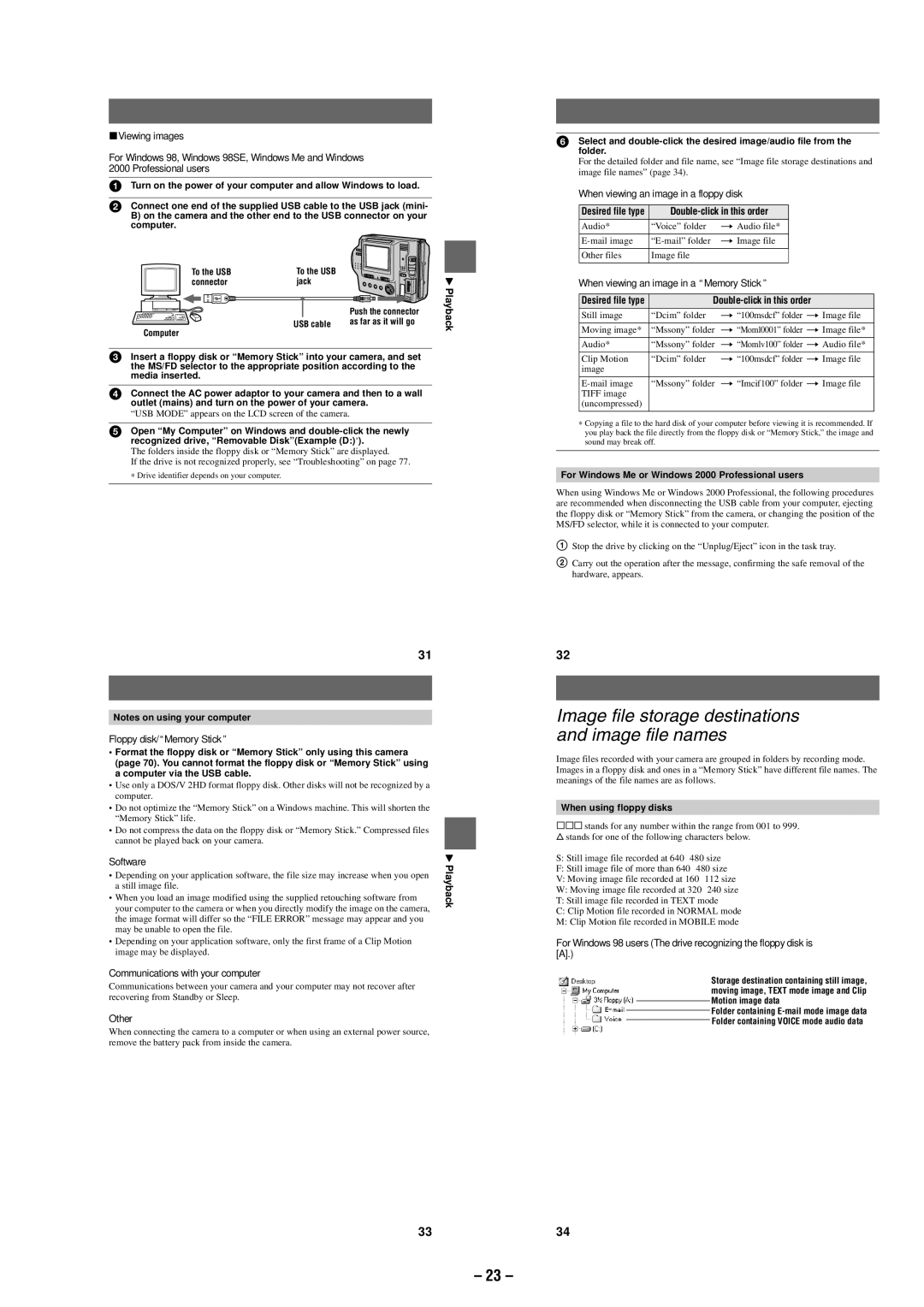
xViewing images
For Windows 98, Windows 98SE, Windows Me and Windows 2000 Professional users
1Turn on the power of your computer and allow Windows to load.
2Connect one end of the supplied USB cable to the USB jack (mini- B) on the camera and the other end to the USB connector on your computer.
To the USB | To the USB |
|
|
connector | jack |
| B |
|
| Push the connector | Playback |
|
|
|
USB cable | as far as it will go |
Computer |
|
3Insert a floppy disk or “Memory Stick” into your camera, and set the MS/FD selector to the appropriate position according to the media inserted.
4Connect the AC power adaptor to your camera and then to a wall outlet (mains) and turn on the power of your camera.
“USB MODE” appears on the LCD screen of the camera.
5Open “My Computer” on Windows and
The folders inside the floppy disk or “Memory Stick” are displayed.
If the drive is not recognized properly, see “Troubleshooting” on page 77.
∗ Drive identifier depends on your computer.
6Select and
For the detailed folder and file name, see “Image file storage destinations and image file names” (page 34).
When viewing an image in a floppy disk
Desired file type |
| ||
Audio* | “Voice” folder | t Audio file* |
|
|
|
|
|
t Image file |
| ||
|
|
|
|
Other files | Image file |
|
|
|
|
| |
When viewing an image in a “Memory Stick ” | |||
|
| ||
Desired file type |
| ||
Still image | “Dcim” folder | t “100msdcf” folder t Image file | |
|
|
| |
Moving image* | “Mssony” folder | t “Moml0001” folder t Image file* | |
|
|
| |
Audio* | “Mssony” folder | t “Momlv100” folder t Audio file* | |
|
|
| |
Clip Motion | “Dcim” folder | t “100msdcf” folder t Image file | |
image |
|
|
|
|
|
| |
“Mssony” folder | t “Imcif100” folder t Image file | ||
TIFF image |
|
|
|
(uncompressed) |
|
|
|
|
|
|
|
∗Copying a file to the hard disk of your computer before viewing it is recommended. If you play back the file directly from the floppy disk or “Memory Stick,” the image and sound may break off.
For Windows Me or Windows 2000 Professional users
When using Windows Me or Windows 2000 Professional, the following procedures are recommended when disconnecting the USB cable from your computer, ejecting the floppy disk or “Memory Stick” from the camera, or changing the position of the MS/FD selector, while it is connected to your computer.
1Stop the drive by clicking on the “Unplug/Eject” icon in the task tray.
2Carry out the operation after the message, confirming the safe removal of the hardware, appears.
31
Notes on using your computer
Floppy disk/“Memory Stick ”
•Format the floppy disk or “Memory Stick” only using this camera (page 70). You cannot format the floppy disk or “Memory Stick” using a computer via the USB cable.
•Use only a DOS/V 2HD format floppy disk. Other disks will not be recognized by a computer.
•Do not optimize the “Memory Stick” on a Windows machine. This will shorten the “Memory Stick” life.
•Do not compress the data on the floppy disk or “Memory Stick.” Compressed files cannot be played back on your camera.
Software | B | |
Playback | ||
• Depending on your application software, the file size may increase when you open | ||
a still image file. |
| |
• When you load an image modified using the supplied retouching software from |
| |
your computer to the camera or when you directly modify the image on the camera, |
| |
the image format will differ so the “FILE ERROR” message may appear and you |
| |
may be unable to open the file. |
| |
• Depending on your application software, only the first frame of a Clip Motion |
| |
image may be displayed. |
| |
Communications with your computer |
| |
Communications between your camera and your computer may not recover after |
| |
recovering from Standby or Sleep. |
| |
Other |
| |
When connecting the camera to a computer or when using an external power source, |
| |
remove the battery pack from inside the camera. |
|
32
Image file storage destinations and image file names
Image files recorded with your camera are grouped in folders by recording mode. Images in a floppy disk and ones in a “Memory Stick” have different file names. The meanings of the file names are as follows.
When using floppy disks
sssstands for any number within the range from 001 to 999. f stands for one of the following characters below.
S:Still image file recorded at 640 480 size
F:Still image file of more than 640 480 size
V:Moving image file recorded at 160 112 size
W:Moving image file recorded at 320 240 size
T:Still image file recorded in TEXT mode
C:Clip Motion file recorded in NORMAL mode
M:Clip Motion file recorded in MOBILE mode
For Windows 98 users (The drive recognizing the floppy disk is [A].)
Storage destination containing still image, moving image, TEXT mode image and Clip Motion image data
Folder containing
33 | 34 |
– 23 –
